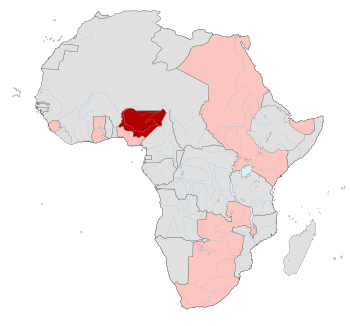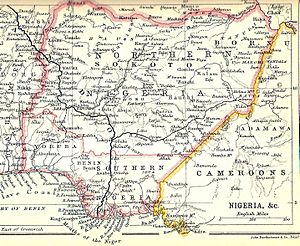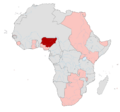Northern Nigeria Protectorate facts for kids
Quick facts for kids
Northern Nigeria Protectorate
|
|||||||||||
|---|---|---|---|---|---|---|---|---|---|---|---|
| 1900–1914 | |||||||||||
|
Anthem: God Save the King/Queen
|
|||||||||||

Northern Nigeria (red)
British possessions in Africa (pink) 1913 |
|||||||||||
| Status | Protectorate of British Empire | ||||||||||
| Capital | Zungeru | ||||||||||
| Common languages | English (official) Hausa, Arabic, Yoruba, Fula, Kanuri widely spoken |
||||||||||
| Religion | Islam, Christianity, Yoruba religion, African traditional religion | ||||||||||
| Government | Constitutional monarchy | ||||||||||
| Monarch | |||||||||||
|
• 1900–1901
|
Victoria | ||||||||||
|
• 1901-1910
|
Edward VII | ||||||||||
|
• 1910–1914
|
George V | ||||||||||
| High Commissioner/Governor | |||||||||||
|
• 1900–1906
|
Sir Frederick Lugard | ||||||||||
|
• 1907–1909
|
Sir Percy Girouard | ||||||||||
|
• 1909–1911
|
Sir Henry Hesketh Bell | ||||||||||
|
• 1911-1912
|
Charles Lindsay Temple acting | ||||||||||
|
• 1912–1914
|
Sir Frederick John Dealtry Lugard | ||||||||||
| History | |||||||||||
|
• Established
|
1 January 1900 | ||||||||||
|
• Disestablished
|
1 January 1914 | ||||||||||
| Currency | Pound sterling (1900–13) British West African pound (1913–14) |
||||||||||
|
|||||||||||
Northern Nigeria was a land in West Africa that was controlled by the British Empire. It existed as a British protectorate from 1900 to 1914. A protectorate is a country that is protected and partly controlled by a stronger country. This area covered the northern part of what we now know as Nigeria.
The protectorate was very large, about 660,000 square kilometers (255,000 square miles). It included lands that were once part of the Sokoto Caliphate and the Bornu Empire. The British took control of these areas. The first leader, called the High Commissioner, was Frederick Lugard. He worked to stop slavery and local conflicts. He also set up a way of governing that used local leaders.
Northern Nigeria stopped being a separate protectorate on January 1, 1914. It was then joined with the Southern Nigeria Protectorate and the Lagos Colony. Together, they became the Northern Province of the Colony and Protectorate of Nigeria.
Contents
How Northern Nigeria Was Formed

At a big meeting in Europe in 1884-1885, called the Berlin Conference, different European countries decided who would control which parts of Africa. The area that became Northern Nigeria was given to the British. In 1886, a company called the Royal Niger Company was formed. George Taubman Goldie was a key leader in this company.
The Royal Niger Company moved inland. They made trade deals and political agreements with local chiefs. Sometimes these agreements were forced. In 1897, Frederick Lugard was put in charge of the West African Frontier Force. This group was meant to stop resistance from the Fulani people. It also aimed to prevent French forces from moving into the area.
On January 1, 1900, the British government took over from the Royal Niger Company. The company was paid a large sum of money. They also got rights to half of all mining money in a big part of the area for 99 years. In return, they gave control of the land to the British government. Lord Lugard became the first High Commissioner of the new Northern Nigeria Protectorate. The first capital was Lokoja in 1900. But in 1902, Zungeru became the main headquarters. This was because it was the furthest north that ships could reach by river.
Military Actions and Control
The British military started operations in 1902. There was fighting for about five years. The British conquered the remaining parts of the Bornu Empire in 1902. The Sokoto Caliphate was defeated in the Battle of Kano in 1903. Fighting continued in 1904 in Bassa.
In 1906, a rebellion started near the city of Sokoto. British forces, along with local soldiers, worked together to stop it. This was the last major armed resistance to British rule in the region. After 1907, there were fewer revolts. The British leaders then focused more on collecting taxes and setting up their government.
How the British Governed
The British government in Northern Nigeria started with Frederick Lugard as the first High Commissioner. A High Commissioner was like the main governor. In 1907, Lugard left Nigeria. Percy Girouard became the new High Commissioner. Girouard had experience building railroads. He was given the job of building many railroads in the Protectorate.
In 1909, Henry Hesketh Bell became High Commissioner. By 1912, Northern Nigeria was estimated to be about 660,000 square kilometers (255,000 square miles). It had about 10 million people. Charles Lindsay Temple was acting High Commissioner in 1911 and 1912. He worked closely with Lugard to create the larger Colony and Protectorate of Nigeria.
A key part of British rule in Northern Nigeria was working with local chiefs and emirs. These local leaders were called "native authorities." They helped the British govern. Collecting taxes was very hard for the British in the first few years. Lugard tried to collect taxes from everyone, but local leaders and powerful traders resisted. This meant the Protectorate often did not have enough money. Public projects had to be paid for by grants from the British Empire. Because of these money problems, the British often had too few British staff before 1907. This led them to include traditional local leaders in their government structure.
These money and management problems led Lugard to suggest joining the Lagos Colony, the Southern Nigeria Protectorate, and Northern Nigeria. The idea was to create one main government in Lagos. Money from customs duties in the south would help pay for projects in the north. The unified Colony and Protectorate of Nigeria started in 1914. It had two lieutenant governors. One was in charge of the southern area, and the other for the northern area. The government in the north stayed mostly separate. It continued to use and rely on local leaders. Many of these divisions still exist today.
See also
- British West Africa
- Northern Nigeria Gazette
- Scramble for Africa
- Sir Richmond Palmer
Images for kids









